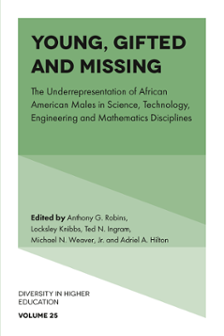
Index
ISBN: 978-1-80117-731-3, eISBN: 978-1-80117-730-6
ISSN: 1479-3644
Publication date: 17 August 2022
Citation
(2022), "Index", Robins, A.G., Knibbs, L., Ingram, T.N., Weaver, M.N. and Hilton, A.A. (Ed.) Young, Gifted and Missing (Diversity in Higher Education, Vol. 25), Emerald Publishing Limited, Leeds, pp. 189-194. https://doi.org/10.1108/S1479-364420220000025015
Publisher
:Emerald Publishing Limited
Copyright © 2022 Anthony G. Robins, Locksley Knibbs, Ted N. Ingram, Michael N. Weaver Jr. and Adriel A. Hilton. Published under exclusive licence by Emerald Publishing Limited
INDEX
- Prelims
- Measuring Grit as a Predictor of Academic Success Among African American Male Students in STEM Programs at Predominantly White Institutions in Western Pennsylvania
- Toward a Solutions Approach to the Problem of Black Underrepresentation in STEM
- Layering Programs: Career Academies as a Plausible Intervention to Increase the Representation of Precollegiate Black Males in STEM
- “He Probably Won't Go to College”: Using Storytelling to Illustrate How Black Boys Use Their Science Knowledge to Challenge Deficit-Based Teacher Dispositions
- STEMfluences: The Role of Social Interaction and Scientific Identity Formation in the Successful Matriculation of African American Males in STEM
- Revisiting W.E.B. Du Bois' Talented Tenth Framework to Create Equity in Education: How Black Philanthropy Can Assist in Leveling the Playing Field in STEM Education
- The Impact of Test Anxiety and Test Bias on the Absence of African American Males in STEM
- Cultivating Science Genius Through Hip-Hop Development and Reality Pedagogy
- What If LeBron James Was a Scientist? The Influence of Role Models on Black Male Youth in STEM Programs
- The Black Code: Employing Culturally Responsive Computing to Help Black Males Thrive in STEM Careers
- Using Talent Centered Education Leadership to Create Equitable and Inclusive Workplaces for Black Male Faculty in Engineering
- Moving Toward an Equitable Approach to STEM Education for Minority Males
- Conclusion
- Index